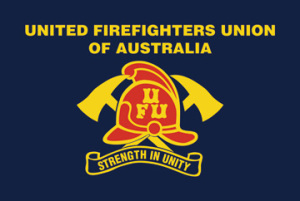UFUA Firefighter Cancer Foundation
Introduction
What we know
Firefighters wear Personal Protecting Clothing (PPC) inside structure (house) fires. This helps protect a Firefighter from heat and flame.
But PPC must breathe to release the metabolic heat build-up as a result of the Firefighter working within this high-temperature heat & flame environment. If the PPC did not breathe, the Firefighter’s major organs would overheat and the Firefighter would perish. The design of Firefighter uniform is an unavoidable compromise.
As a Firefighter is working hard to put out the fire, upwards of 10,000 toxins and chemicals leech into their skin and, consequently, their blood stream. This is known as dermal absorption. This is an unavoidable risk. It is a Firefighter’s reality.
Healthy Worker Effect – Workers in other industries have a 30% less chance of contracting cancer.
It’s not one fire that kills firefighters – it’s hundreds – it’s the cumulative effect which results in the firefighters contracting various types of cancers.
History
- 2002 Tee Guidotti and David Goldsmith “That it is reasonable given the available scientific evidence to adopt a policy of presumption for brain cancer, bladder cancer, kidney cancer, non-Hodgkin’s lymphoma (lymphatic cancer) and leukemia (hematopoietic cancer) for claims association with occupation as a firefighter.”
- Bates (2001 NZ) demonstrated an increased risk of testicular cancer in career NZ firefighters even when previously identified testicular cancer cluster cases were excluded.
- Baris (Philadelphia 2001)study of career Philadephia firefighters reported statistically significant excess risks for colon, multiple myeloma and non-Hodgkins lymphomas.
- 2006 LeMasters et al A Meta-analysis of 32 studies of firefighters and cancer incidence and mortality that included approximately 110,000 full time career firefighters over the 32 studies from Australia, NZ, USA, Canada, Britain, France, Denmark which found increased cancer incidence for multiple myeloma, non-Hodgkin lymphoma, prostate, testicular, stomach, colon, rectum, skin, malignant melanoma, brain and leukemia.
- NIOSH (2013) was a mortality and cancer incidence study of a cohort of approximately 30,000 career firefiighters in San Francisco, Chicago and Philadelphia which demonstrated an excess cancer mortality rate and incidence for mesothelioma, respiratory, digestive and urinary system cancers.“Our results provide evidence of a relation between firefighting and cancer.”
- NIOSH (2015) examined the relationship between the level of exposures and the incidence of cancer among the 2013 cohort of approximately 30,000 career firefiighters in San Francisco, Chicago and Philadelphia in the above 2013 study. “Significant positive associations between fire-hours and lung cancer mortality and incidence were evident. A similar relation between leukaemia mortality and fire-runs was also found.”
- Monash Study (2014) was the largest single study of career and volunteer firefighters and found:
- The overall the cancer incidence for career firefighters was significantly raised compared to the Australian general population, and in particular for male career full time firefighters, a statistically significant increase in prostate cancer, significant increased risk of melanoma, significantly higher risk of kidney cancer, amongst other findings.
- The incidence of cancer is significantly raised for male career firefighters who work for 20 years or more.
Protection for Firefighters in Australia
In 2011, an Australian Senate Inquiry examined a Bill to introduce Presumptive Cancer Laws for Federal Firefighters. The Bill was the first of its kind in Australia. Following testimony around the country from Firefighters, Firefighter Widows and international Firefighter Cancer Law experts, the Senate Inquiry issued its Final Report, stating in part:
“The community holds a deep respect and gratitude for those who serve to protect and assist. If we are honest, however, along with this respect and gratitude comes a generous dose of expectation. We expect firefighters to come to our assistance when our homes, schools, hospitals and businesses are ablaze. We expect that a firefighter will enter a burning building when every human instinct tells us to leave. We expect they will search for those trapped inside and bring them out alive. We expect them to do what they can to minimise loss of life and damage to property. While everyone else is fleeing danger, it is the firefighter’s duty to tackle it head-on, to enter an extreme and dangerous environment, armed with the best protective gear available.
It is a duty firefighters take seriously, aware of the inherent risks to their own health and safety. This awareness on their part does not mitigate the community’s responsibility towards them.
The committee has carefully examined the large amount of evidence with which it has been presented. Study after study has pointed to a higher risk of cancer for firefighters than the general population. Science has confirmed what firefighters suspected for decades: that a disproportionate number of them in the prime of their lives are brought down with illnesses usually reserved for the old and the infirm.
The committee recognises that when a person spends their professional career inhaling and absorbing known—and probably some as yet unknown—carcinogens in the course of public service, it is the moral duty of the community to enable them to seek compensation should they fall ill as a consequence. For this reason the committee believes this Bill needs to be passed after being improved upon through incorporation of the committee’s amendments.”
The Senate Inquiry recommended that the Cancer Law Bill be passed – and it was. The Bill was then replicated in each State around the country over the next 8 years.
Firefighter presumptive laws can be traced back to laws created for chimney sweeps. At height of industrial revolution, children used as chimney sweeps. Created the Chimney Sweeps Act – these were the first presumptive laws.
Today
Epidemiological studies are now moving to bio/molecular studies.
When you go into fire, absorbs into body, many cancer-causing agents in body from 48-72 hours. PFAS and Benzene, for example, stay in body for longer time. When you are young, body can fight off carcinogens. As you get older, less ability to do so.
Cancer changing issues are at cell levels. Tumor is a manipulation of cells.
This doesn’t work for any other profession – don’t see it any other type of occupation.
Cancer risk is real. Cancer risk is underestimated. No way to protect ourselves.
In Australia, we need to expand Presumptive Legislation to 19 cancers as is happening internationally. We also need to ensure research continues to uncover new and emerging exposures.
This foundation is an important key to driving this outcome so that firefighters who put their lives on the line to protect us can get the help they need should they contract one of these cancers.
We invite you to watch the below video’s of the UFUA 2022 Firefighters Cancer Forum to hear the latest news and expert commentary from the world experts on this important topic.

